Accounting Theory and Practice: Fair Value Analysis Report
VerifiedAdded on 2020/11/23
|6
|1316
|83
Report
AI Summary
This report delves into the intricacies of fair value (FV) accounting, a crucial aspect of financial reporting. It begins by defining FV and outlining its pros and cons, such as providing accurate results and enhancing decision-making, but also highlighting potential drawbacks like market volatility and estimation challenges. The report then explains the three-tier process used in FV estimation, emphasizing the preference for market-based measures and the importance of data quality, market information, and valuation models. Furthermore, it identifies and analyzes the qualitative characteristics of financial information essential for effective FV application, including relevance, materiality, comparability, reliability, and understandability. The conclusion summarizes the significance of FV in presenting a company's financial position accurately and emphasizes the importance of adhering to qualitative characteristics for reliable financial reporting.
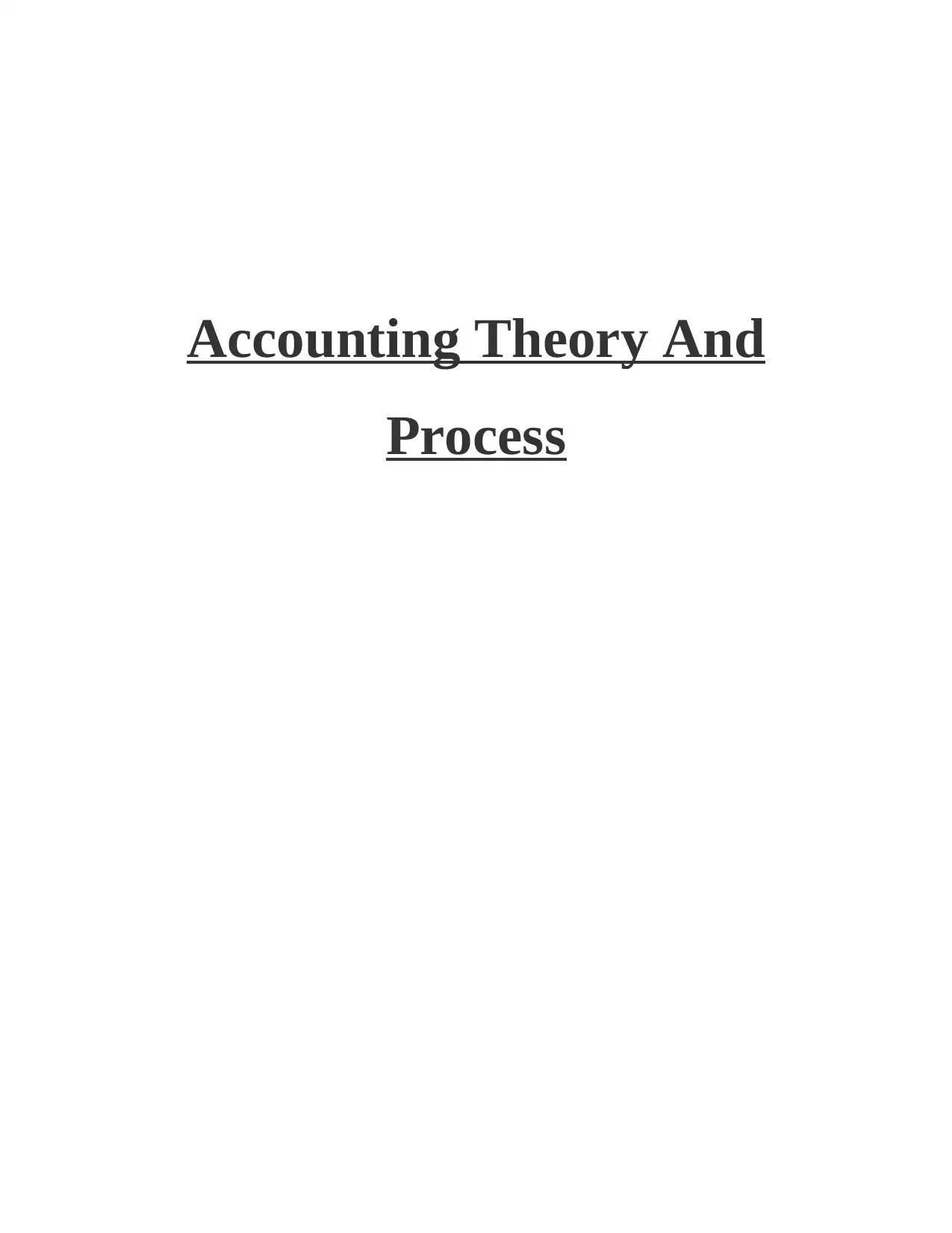
Accounting Theory And
Process
Process
Paraphrase This Document
Need a fresh take? Get an instant paraphrase of this document with our AI Paraphraser
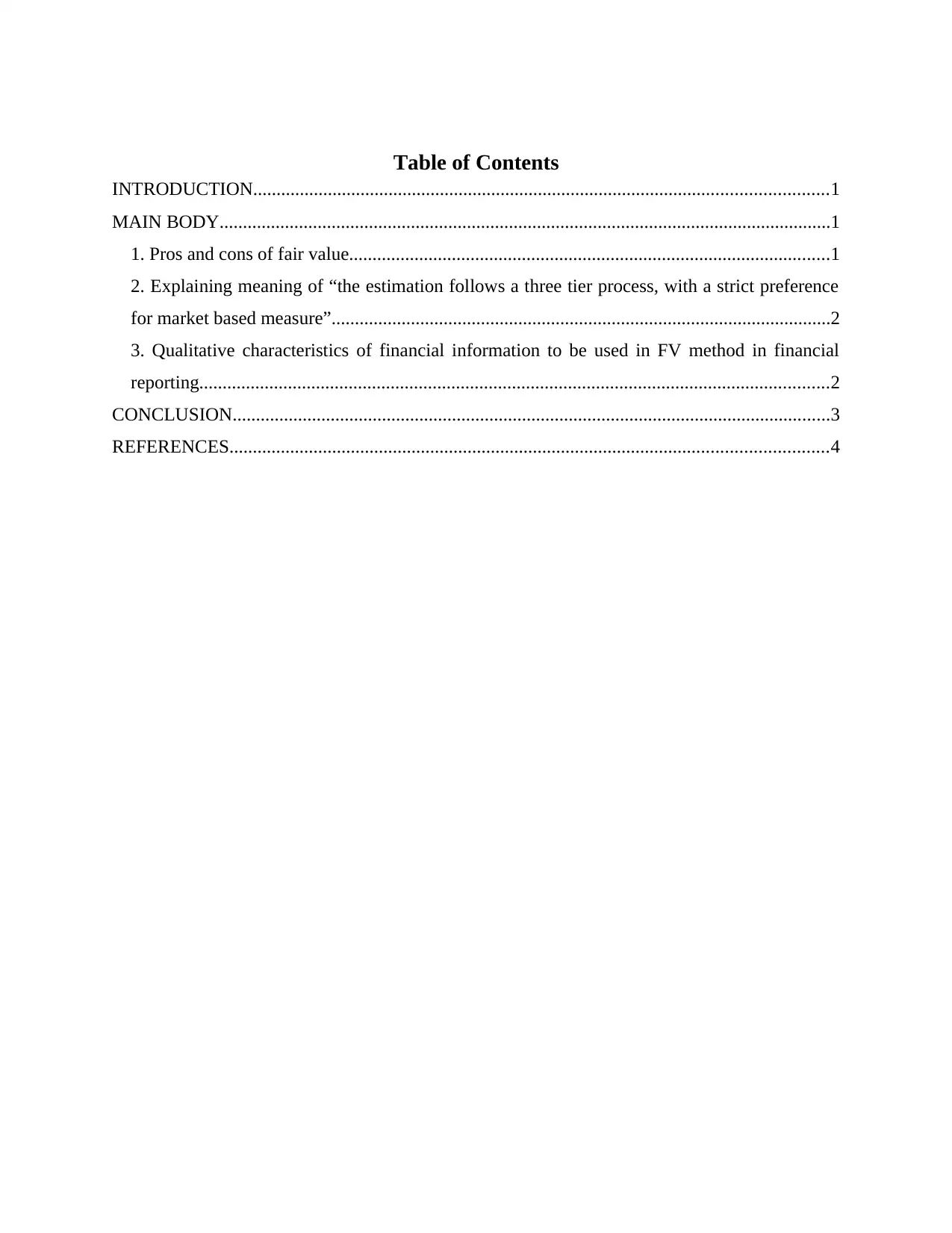
Table of Contents
INTRODUCTION...........................................................................................................................1
MAIN BODY...................................................................................................................................1
1. Pros and cons of fair value.......................................................................................................1
2. Explaining meaning of “the estimation follows a three tier process, with a strict preference
for market based measure”...........................................................................................................2
3. Qualitative characteristics of financial information to be used in FV method in financial
reporting.......................................................................................................................................2
CONCLUSION................................................................................................................................3
REFERENCES................................................................................................................................4
INTRODUCTION...........................................................................................................................1
MAIN BODY...................................................................................................................................1
1. Pros and cons of fair value.......................................................................................................1
2. Explaining meaning of “the estimation follows a three tier process, with a strict preference
for market based measure”...........................................................................................................2
3. Qualitative characteristics of financial information to be used in FV method in financial
reporting.......................................................................................................................................2
CONCLUSION................................................................................................................................3
REFERENCES................................................................................................................................4
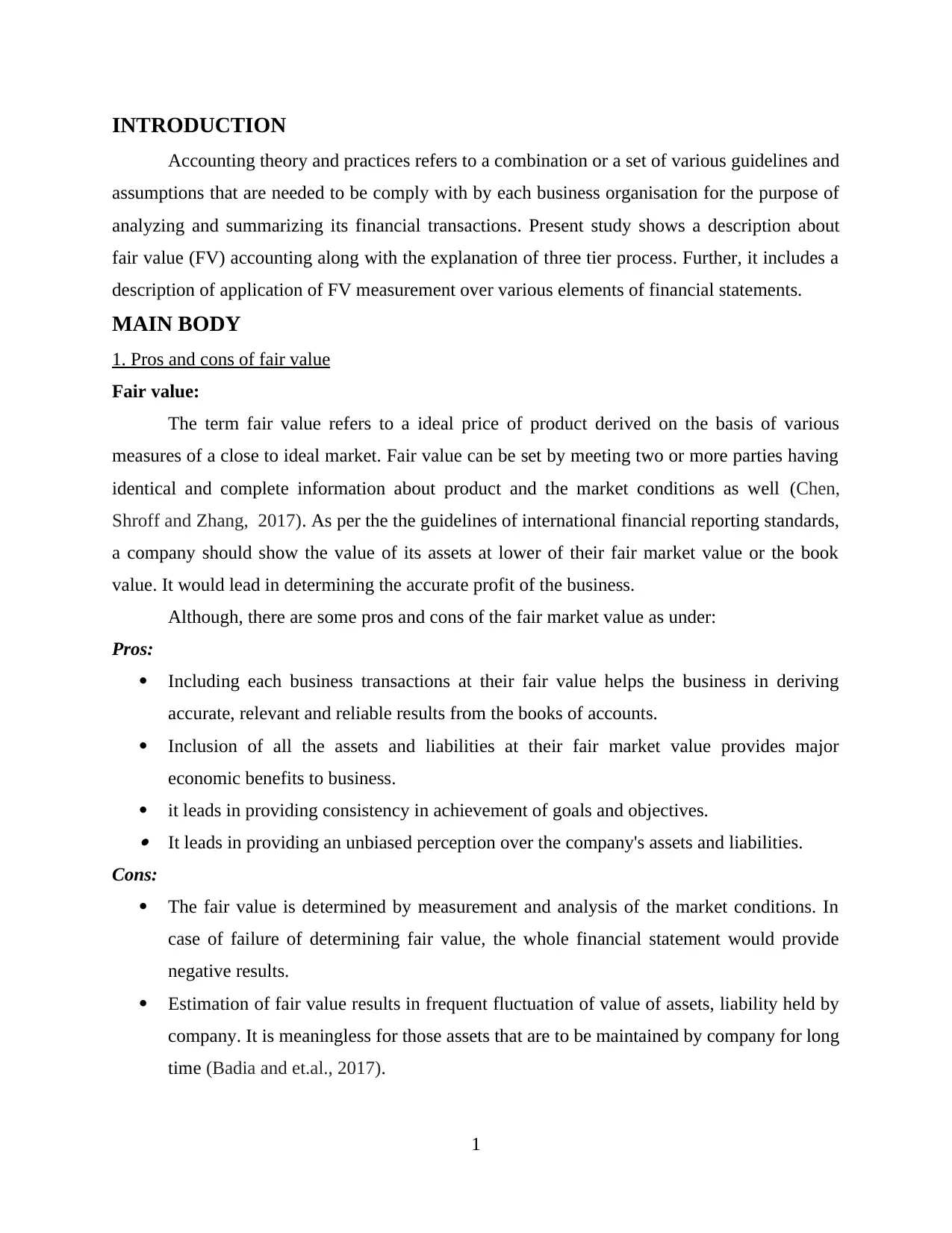
INTRODUCTION
Accounting theory and practices refers to a combination or a set of various guidelines and
assumptions that are needed to be comply with by each business organisation for the purpose of
analyzing and summarizing its financial transactions. Present study shows a description about
fair value (FV) accounting along with the explanation of three tier process. Further, it includes a
description of application of FV measurement over various elements of financial statements.
MAIN BODY
1. Pros and cons of fair value
Fair value:
The term fair value refers to a ideal price of product derived on the basis of various
measures of a close to ideal market. Fair value can be set by meeting two or more parties having
identical and complete information about product and the market conditions as well (Chen,
Shroff and Zhang, 2017). As per the the guidelines of international financial reporting standards,
a company should show the value of its assets at lower of their fair market value or the book
value. It would lead in determining the accurate profit of the business.
Although, there are some pros and cons of the fair market value as under:
Pros:
Including each business transactions at their fair value helps the business in deriving
accurate, relevant and reliable results from the books of accounts.
Inclusion of all the assets and liabilities at their fair market value provides major
economic benefits to business.
it leads in providing consistency in achievement of goals and objectives. It leads in providing an unbiased perception over the company's assets and liabilities.
Cons:
The fair value is determined by measurement and analysis of the market conditions. In
case of failure of determining fair value, the whole financial statement would provide
negative results.
Estimation of fair value results in frequent fluctuation of value of assets, liability held by
company. It is meaningless for those assets that are to be maintained by company for long
time (Badia and et.al., 2017).
1
Accounting theory and practices refers to a combination or a set of various guidelines and
assumptions that are needed to be comply with by each business organisation for the purpose of
analyzing and summarizing its financial transactions. Present study shows a description about
fair value (FV) accounting along with the explanation of three tier process. Further, it includes a
description of application of FV measurement over various elements of financial statements.
MAIN BODY
1. Pros and cons of fair value
Fair value:
The term fair value refers to a ideal price of product derived on the basis of various
measures of a close to ideal market. Fair value can be set by meeting two or more parties having
identical and complete information about product and the market conditions as well (Chen,
Shroff and Zhang, 2017). As per the the guidelines of international financial reporting standards,
a company should show the value of its assets at lower of their fair market value or the book
value. It would lead in determining the accurate profit of the business.
Although, there are some pros and cons of the fair market value as under:
Pros:
Including each business transactions at their fair value helps the business in deriving
accurate, relevant and reliable results from the books of accounts.
Inclusion of all the assets and liabilities at their fair market value provides major
economic benefits to business.
it leads in providing consistency in achievement of goals and objectives. It leads in providing an unbiased perception over the company's assets and liabilities.
Cons:
The fair value is determined by measurement and analysis of the market conditions. In
case of failure of determining fair value, the whole financial statement would provide
negative results.
Estimation of fair value results in frequent fluctuation of value of assets, liability held by
company. It is meaningless for those assets that are to be maintained by company for long
time (Badia and et.al., 2017).
1
⊘ This is a preview!⊘
Do you want full access?
Subscribe today to unlock all pages.

Trusted by 1+ million students worldwide
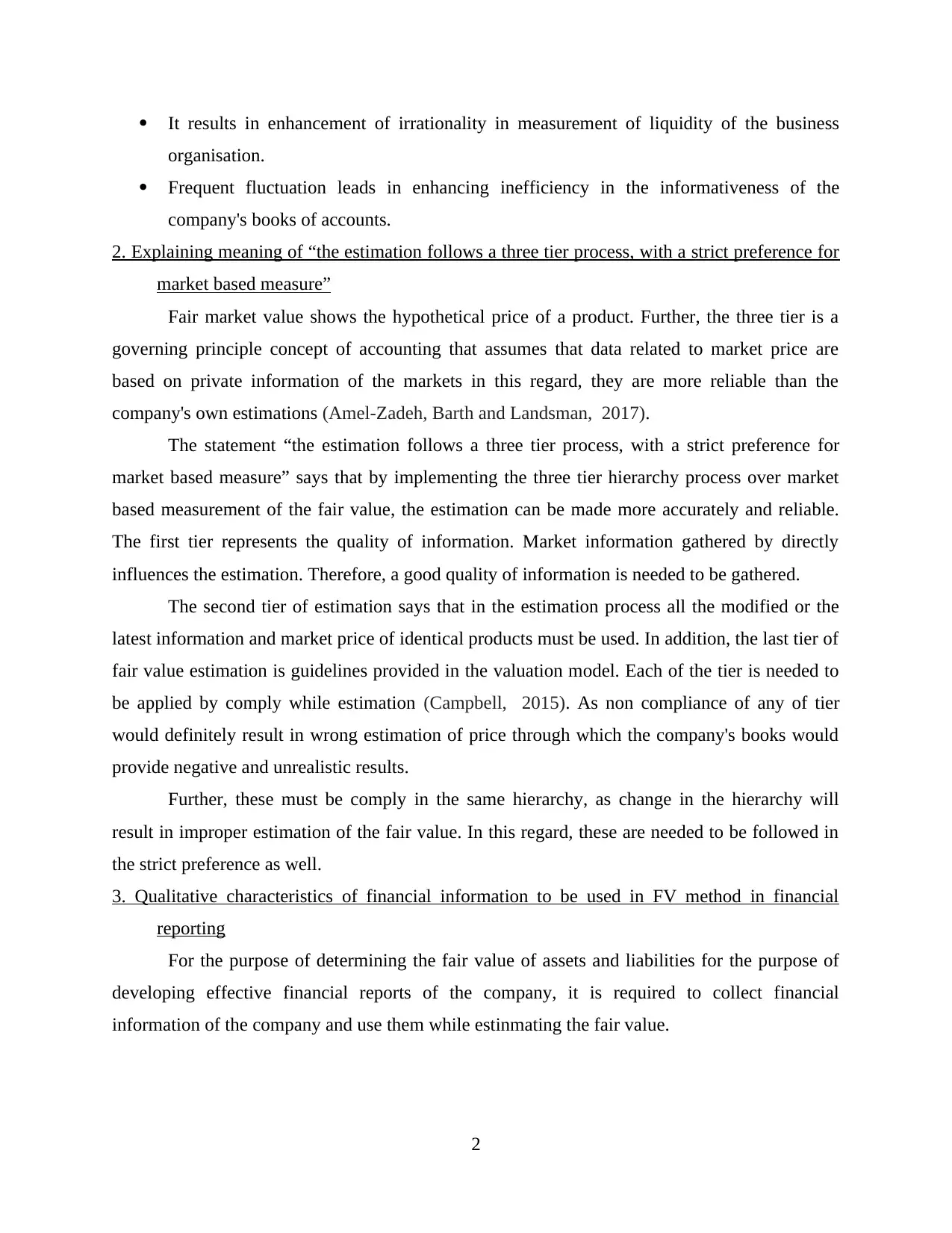
It results in enhancement of irrationality in measurement of liquidity of the business
organisation.
Frequent fluctuation leads in enhancing inefficiency in the informativeness of the
company's books of accounts.
2. Explaining meaning of “the estimation follows a three tier process, with a strict preference for
market based measure”
Fair market value shows the hypothetical price of a product. Further, the three tier is a
governing principle concept of accounting that assumes that data related to market price are
based on private information of the markets in this regard, they are more reliable than the
company's own estimations (Amel-Zadeh, Barth and Landsman, 2017).
The statement “the estimation follows a three tier process, with a strict preference for
market based measure” says that by implementing the three tier hierarchy process over market
based measurement of the fair value, the estimation can be made more accurately and reliable.
The first tier represents the quality of information. Market information gathered by directly
influences the estimation. Therefore, a good quality of information is needed to be gathered.
The second tier of estimation says that in the estimation process all the modified or the
latest information and market price of identical products must be used. In addition, the last tier of
fair value estimation is guidelines provided in the valuation model. Each of the tier is needed to
be applied by comply while estimation (Campbell, 2015). As non compliance of any of tier
would definitely result in wrong estimation of price through which the company's books would
provide negative and unrealistic results.
Further, these must be comply in the same hierarchy, as change in the hierarchy will
result in improper estimation of the fair value. In this regard, these are needed to be followed in
the strict preference as well.
3. Qualitative characteristics of financial information to be used in FV method in financial
reporting
For the purpose of determining the fair value of assets and liabilities for the purpose of
developing effective financial reports of the company, it is required to collect financial
information of the company and use them while estinmating the fair value.
2
organisation.
Frequent fluctuation leads in enhancing inefficiency in the informativeness of the
company's books of accounts.
2. Explaining meaning of “the estimation follows a three tier process, with a strict preference for
market based measure”
Fair market value shows the hypothetical price of a product. Further, the three tier is a
governing principle concept of accounting that assumes that data related to market price are
based on private information of the markets in this regard, they are more reliable than the
company's own estimations (Amel-Zadeh, Barth and Landsman, 2017).
The statement “the estimation follows a three tier process, with a strict preference for
market based measure” says that by implementing the three tier hierarchy process over market
based measurement of the fair value, the estimation can be made more accurately and reliable.
The first tier represents the quality of information. Market information gathered by directly
influences the estimation. Therefore, a good quality of information is needed to be gathered.
The second tier of estimation says that in the estimation process all the modified or the
latest information and market price of identical products must be used. In addition, the last tier of
fair value estimation is guidelines provided in the valuation model. Each of the tier is needed to
be applied by comply while estimation (Campbell, 2015). As non compliance of any of tier
would definitely result in wrong estimation of price through which the company's books would
provide negative and unrealistic results.
Further, these must be comply in the same hierarchy, as change in the hierarchy will
result in improper estimation of the fair value. In this regard, these are needed to be followed in
the strict preference as well.
3. Qualitative characteristics of financial information to be used in FV method in financial
reporting
For the purpose of determining the fair value of assets and liabilities for the purpose of
developing effective financial reports of the company, it is required to collect financial
information of the company and use them while estinmating the fair value.
2
Paraphrase This Document
Need a fresh take? Get an instant paraphrase of this document with our AI Paraphraser
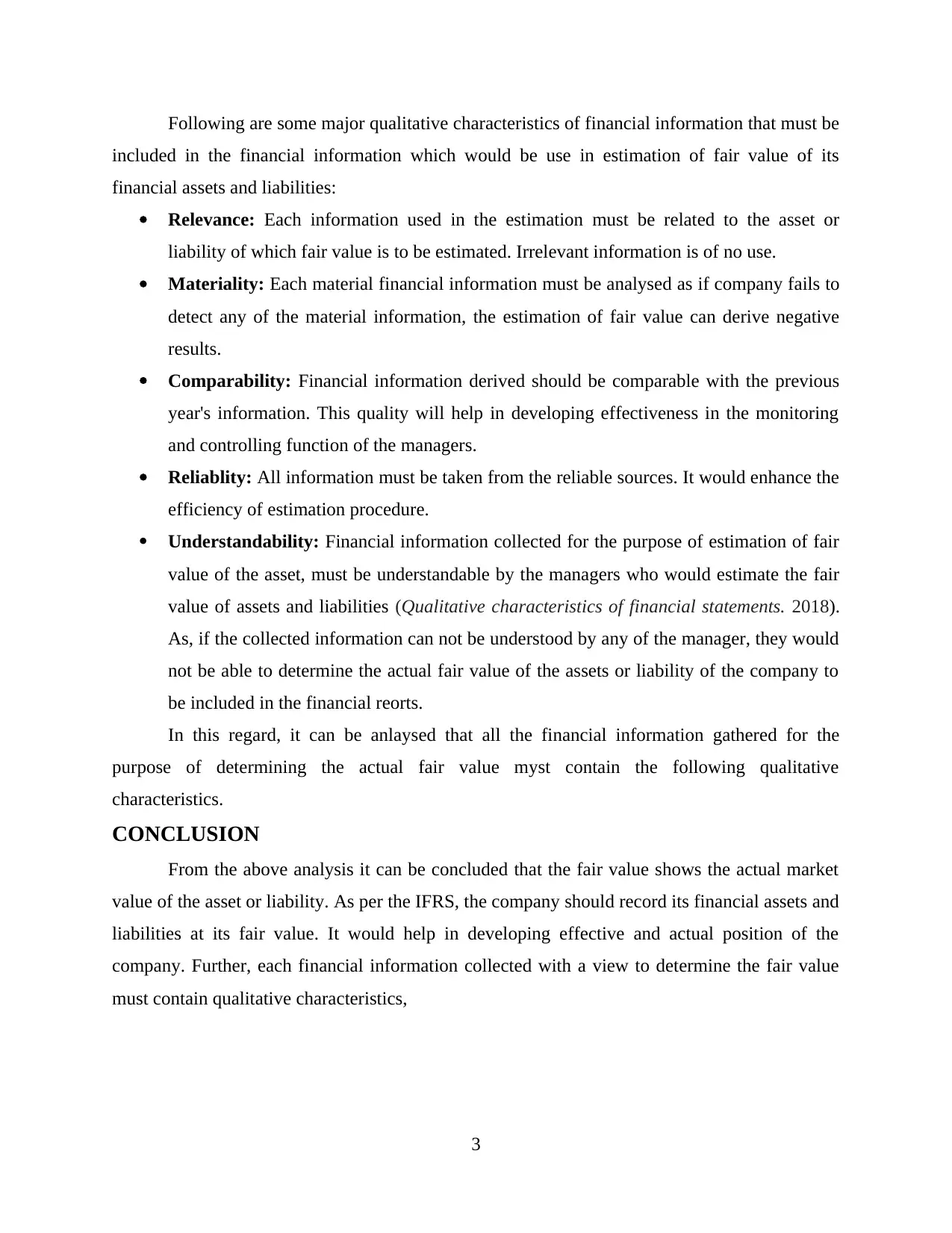
Following are some major qualitative characteristics of financial information that must be
included in the financial information which would be use in estimation of fair value of its
financial assets and liabilities:
Relevance: Each information used in the estimation must be related to the asset or
liability of which fair value is to be estimated. Irrelevant information is of no use.
Materiality: Each material financial information must be analysed as if company fails to
detect any of the material information, the estimation of fair value can derive negative
results.
Comparability: Financial information derived should be comparable with the previous
year's information. This quality will help in developing effectiveness in the monitoring
and controlling function of the managers.
Reliablity: All information must be taken from the reliable sources. It would enhance the
efficiency of estimation procedure.
Understandability: Financial information collected for the purpose of estimation of fair
value of the asset, must be understandable by the managers who would estimate the fair
value of assets and liabilities (Qualitative characteristics of financial statements. 2018).
As, if the collected information can not be understood by any of the manager, they would
not be able to determine the actual fair value of the assets or liability of the company to
be included in the financial reorts.
In this regard, it can be anlaysed that all the financial information gathered for the
purpose of determining the actual fair value myst contain the following qualitative
characteristics.
CONCLUSION
From the above analysis it can be concluded that the fair value shows the actual market
value of the asset or liability. As per the IFRS, the company should record its financial assets and
liabilities at its fair value. It would help in developing effective and actual position of the
company. Further, each financial information collected with a view to determine the fair value
must contain qualitative characteristics,
3
included in the financial information which would be use in estimation of fair value of its
financial assets and liabilities:
Relevance: Each information used in the estimation must be related to the asset or
liability of which fair value is to be estimated. Irrelevant information is of no use.
Materiality: Each material financial information must be analysed as if company fails to
detect any of the material information, the estimation of fair value can derive negative
results.
Comparability: Financial information derived should be comparable with the previous
year's information. This quality will help in developing effectiveness in the monitoring
and controlling function of the managers.
Reliablity: All information must be taken from the reliable sources. It would enhance the
efficiency of estimation procedure.
Understandability: Financial information collected for the purpose of estimation of fair
value of the asset, must be understandable by the managers who would estimate the fair
value of assets and liabilities (Qualitative characteristics of financial statements. 2018).
As, if the collected information can not be understood by any of the manager, they would
not be able to determine the actual fair value of the assets or liability of the company to
be included in the financial reorts.
In this regard, it can be anlaysed that all the financial information gathered for the
purpose of determining the actual fair value myst contain the following qualitative
characteristics.
CONCLUSION
From the above analysis it can be concluded that the fair value shows the actual market
value of the asset or liability. As per the IFRS, the company should record its financial assets and
liabilities at its fair value. It would help in developing effective and actual position of the
company. Further, each financial information collected with a view to determine the fair value
must contain qualitative characteristics,
3
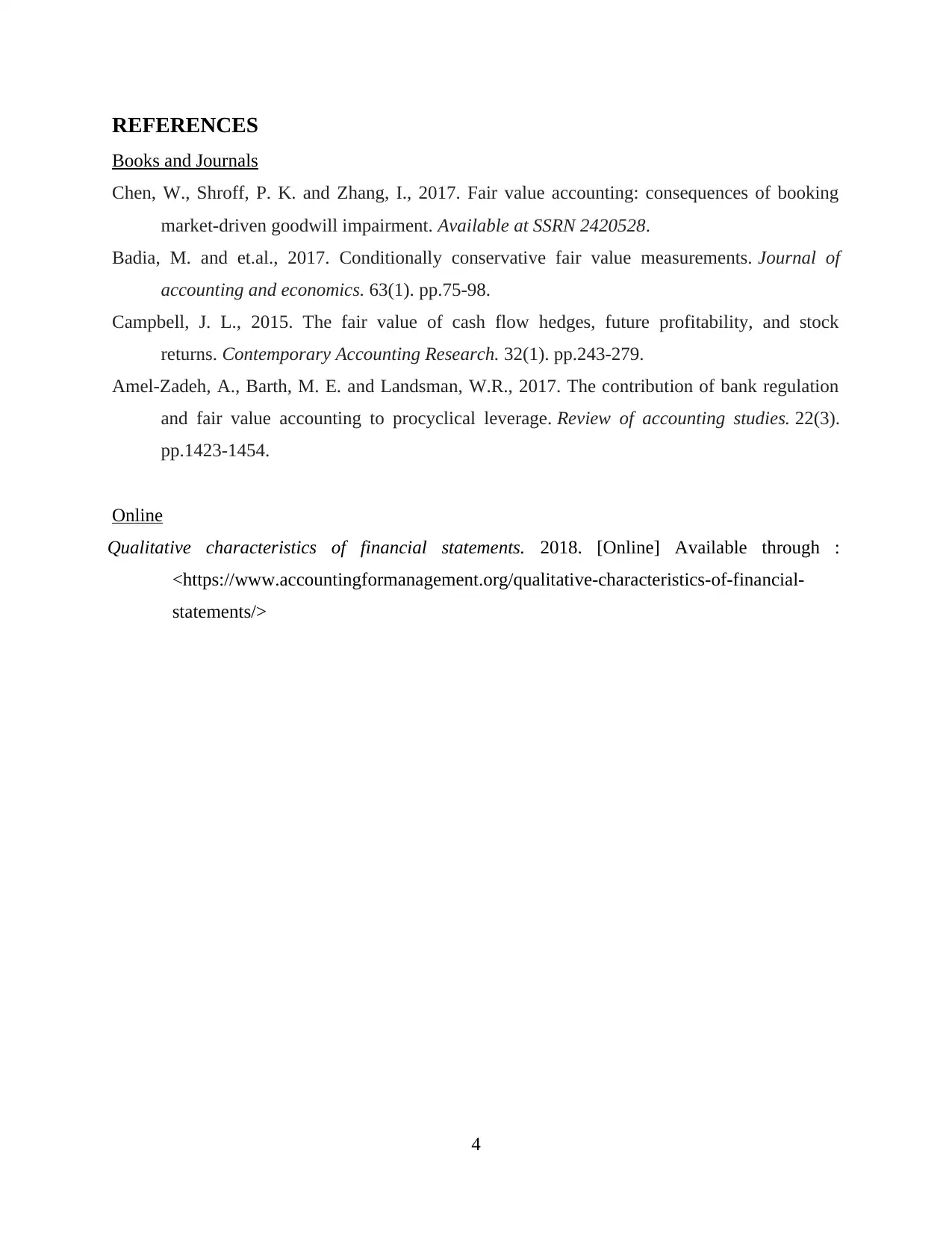
REFERENCES
Books and Journals
Chen, W., Shroff, P. K. and Zhang, I., 2017. Fair value accounting: consequences of booking
market-driven goodwill impairment. Available at SSRN 2420528.
Badia, M. and et.al., 2017. Conditionally conservative fair value measurements. Journal of
accounting and economics. 63(1). pp.75-98.
Campbell, J. L., 2015. The fair value of cash flow hedges, future profitability, and stock
returns. Contemporary Accounting Research. 32(1). pp.243-279.
Amel-Zadeh, A., Barth, M. E. and Landsman, W.R., 2017. The contribution of bank regulation
and fair value accounting to procyclical leverage. Review of accounting studies. 22(3).
pp.1423-1454.
Online
Qualitative characteristics of financial statements. 2018. [Online] Available through :
<https://www.accountingformanagement.org/qualitative-characteristics-of-financial-
statements/>
4
Books and Journals
Chen, W., Shroff, P. K. and Zhang, I., 2017. Fair value accounting: consequences of booking
market-driven goodwill impairment. Available at SSRN 2420528.
Badia, M. and et.al., 2017. Conditionally conservative fair value measurements. Journal of
accounting and economics. 63(1). pp.75-98.
Campbell, J. L., 2015. The fair value of cash flow hedges, future profitability, and stock
returns. Contemporary Accounting Research. 32(1). pp.243-279.
Amel-Zadeh, A., Barth, M. E. and Landsman, W.R., 2017. The contribution of bank regulation
and fair value accounting to procyclical leverage. Review of accounting studies. 22(3).
pp.1423-1454.
Online
Qualitative characteristics of financial statements. 2018. [Online] Available through :
<https://www.accountingformanagement.org/qualitative-characteristics-of-financial-
statements/>
4
⊘ This is a preview!⊘
Do you want full access?
Subscribe today to unlock all pages.

Trusted by 1+ million students worldwide
1 out of 6
Related Documents
Your All-in-One AI-Powered Toolkit for Academic Success.
+13062052269
info@desklib.com
Available 24*7 on WhatsApp / Email
![[object Object]](/_next/static/media/star-bottom.7253800d.svg)
Unlock your academic potential
Copyright © 2020–2025 A2Z Services. All Rights Reserved. Developed and managed by ZUCOL.





